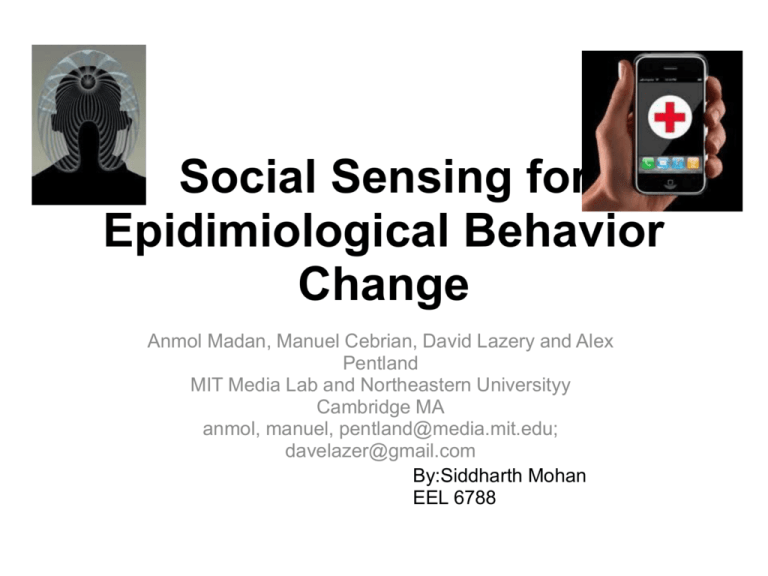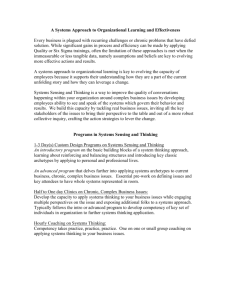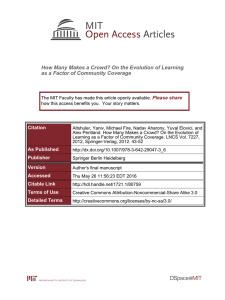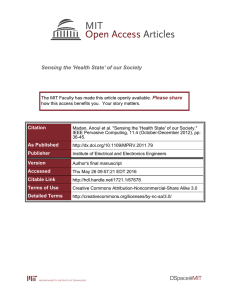SocialSensing-EpidimiologicalBehavior
advertisement

Social Sensing for Epidimiological Behavior Change Anmol Madan, Manuel Cebrian, David Lazery and Alex Pentland MIT Media Lab and Northeastern Universityy Cambridge MA anmol, manuel, pentland@media.mit.edu; davelazer@gmail.com By:Siddharth Mohan EEL 6788 Content • • • • • • • • • • • Introduction A brief on terms Behavioral effects Study(survey) Mobile sensing platform Platform architecture Daily Survey launcher Battery impact Behavioral effects PSI method+ results Conclusion Introduction • This paper describes a novel application of ubiquitous computing. • In this paper they use mobile phones as an active sensing and prediction platform to identify behavior changes reflected in mobile phone sensors. Common Colds, Influenza, Fever, Stress and Mild Depression • It also emphasizes the possibility in determining the health status of individuals using information gathered by mobile phones, without having actual health measurements of the individuals involved. A Brief on Terms • Epidemiology - The study of patterns of health and illness and associated factors at the population level. • Ubiquitous Computing - Existence or being everywhere at the same time • Reality Mining - It is the collection and analysis of machine-sensed environmental data pertaining to human social behavior, with the goal of identifying predictable patterns of behavior This paper is all about… In this paper, they use a mobile phone based co-location and communication sensing to measure the characteristic behavior changes in symptomatic individuals. Behavioral effects • Introverts, isolates, and persons lacking social skills may also be at increased risk for both illness behaviors and pathology. • Stress depletes local immune protection, increasing susceptibility to colds and flu. • Psychological disturbances could develop in response to frequent illness. Study • An experiment was conducted taking into consideration residents of an undergraduate dormitory for two months, from February to April 2009. • Individuals were surveyed on a day-to-day basis for symptoms of contagious diseases like common colds, influenza & gastroenteritis. • The characteristic changes in behavior when individuals are sick, are reflected in automatically captured features like their total communication,communication patterns with respect to time of day (e.g. late night, early morning), diversity of their network. Mobile Sensing Platform Device Selection • The platform is based on Windows Mobile 6.x devices, software was written using a combination of native-C and managed-C#. • All supported devices featured WLAN,EDGE and SD Card storage, and most featured touch screens. Communication • The software logged Call and SMS details on the device every 20 minutes, based on recent events. • These logs included information about missed calls and calls not completed. Platform Architecture Daily Survey Launcher • • • • • • Do you have a sore throat or cough? Do you have a runny nose, congestion or sneezing? Do you have a fever? Have you had any vomiting, nausea or diarrhea? Have you been feeling sad, lonely or depressed lately? Have you been feeling stressed out lately? • The application launches a foreground survey dialog at 6am everyday that asks the user to respond to six survey questions. • Users were paid $1 USD for every completed daily survey as participation incentive. Battery Impact • Periodic scanning of Blue- tooth and WLAN APs reduced operational battery life by approximately 10-15 percent • Based on the service model & individual usage patterns, the average usable battery life was between 14-24 hours • Using wireless Internet on Windows Mobile devices for 4-5 hours continuously on some handset models can drain batteries completely Behavioral Effects of Low Intensity Symptoms • For a runny nose condition,participants showed increased total communication as well as increased late-night early morning communication. • Total counts of Bluetooth proximity and measures of WLAN entropy increases, which is perhaps counter-intuitive. Behavior Effects of Higher-Intensity Symptoms • For fever, variations are observed in the late night early morning behavior • Phone communication,buletooth proximity counts & bluetooth entropy all show a decrease for late night-early morning window. Phase Slope Index Method • Spectral estimation method designed to measure temporal information flux between time-series signals. • It is based on the knowledge that phase slope of the crossspectrum of two signals can be used to estimate information flux between these signals in the time domain. • More noise immune then Granger analysis Results • We run PSI on two time series of varying length n, representing number of continous samples available per user. • In order to apply PSI to our dataset, the subset of participants that show both physical symptoms and stress and depression related responses are considered. Related work Mobile phones as social sensors • Reality Mining • Random walk or Levy flight models • Sociometric badge Conclusion • The analysis in this paper does account for confounding behavior changes due to various external events, e.g. exams • Prediction model does not use stochastic information about symptoms or behaviors from previous days • Mobile sensing & modeling aspect well discussed in this paper To conclude Strengths • The paper emphasizes on important factors related to epidimiology with reachable information • Ubiquitous computing & its norms are brought to light • It is shown that it possible to determine the health status of individuals using information gathered by mobile phones alone, without having actual health measurements about the subject Weakness • A study considering people of a larger society would make it more reachable. • More emphasis on internal patterns with proper definitions Questions









